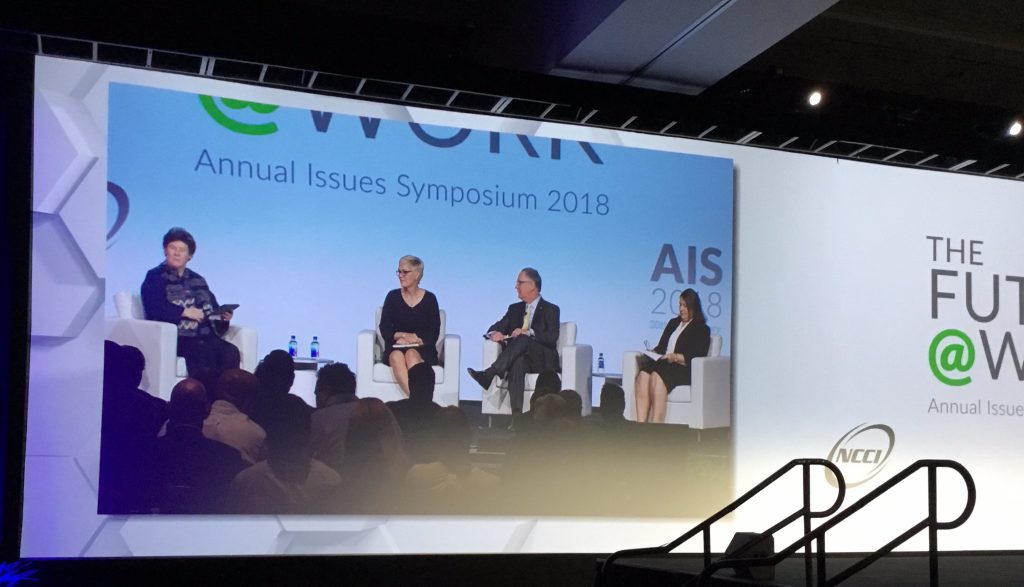Risk Manager’s View of Workers’ Compensation
At the 2018 NCCI Annual Issues Symposium, a panel of risk managers discussed the evolving workforce and it’s impact on workers’ compensation. The panel included:
- Susan Donegan – Chief Regulatory Officer, NCCI (moderator)
- Michelle Adams – VP Risk Management Services, Walt Disney World Resort
- Marc Salm – VP Risk Management, Publix Super Markets, Inc.
- Melanie Stanisic – Manager Risk Management, Darden Restaurants, Inc.
Two of the three programs represented on the panel self-administer their workers’ compensation programs. Walt Disney World has all their employees at a single location which provides them with some distinct advantages compared to employers spread over a large number of locations.
Question: How are you seeing your workforce evolve?
Answers:
- They have an extremely diverse workforce both in terms of age and ethnicity. Six different languages are spoken on property. They also employ a large number of college students and retirees. They are challenged to find employees in the trade industries as not enough new workers are going into the trade industries which is creating a labor shortage. They employ every single job classification in the state of Florida.
- They are not moving to self-checkouts like many retailers as their customers do not want that. They are seeing less people who desire to make a career out of their job which years ago was common. They are also challenged to find employees willing to work the wide variety of hours they require including weekends, evenings, and holidays. They have an older workforce which leads to less injury frequency but high loss severity.
- Their workers under age 50 are 88% of their frequency and most of their incurred costs. They employ a significant number of workers over age 50 but their experience is that they have both lower claim frequency and severity.
Question: What are your main injuries?
Answers:
- Slip, trips and falls are their most common injuries.
- They see a lot of sprain/strain injuries from lifting. Also a lot of cut/puncture injuries mostly from either the meat-cutting or deli departments. They focused on no-slip shoes which reduced these injuries.
- They have had a focused attempt to reduce injuries. The injuries they see are similar to other employers. Many of their injuries happen because of complacency with people going through the motions and not paying enough attention to the details.
Question: What impact is things like telemedicine or on-site clinics having on your program?
Answers:
- We are putting telemedicine clinics in 50 of our stores in Florida. We are looking for a way to use these for our retail workforce. They have two warehouse/corporate facilities that have on-site clinics and these have a significant positive impact on the losses for those facilities. However, these on-site clinics are not cheap to operate so you need to have a large enough workforce at the location to justify it.
- Most of our care is handled in-house as they have fully staffed clinics which include physical therapy. They also have on-site athletic trainers which helps with injury prevention. The prompt treatment they provide coupled with the training helps keep their losses significantly lower than what would be seen in other settings.
- On-site physical therapy has been a game changer for them in terms of costs and outcomes.
- We have no on-site clinics. We are using telephonic nurse triage which has had a positive impact on our claims costs and lost time frequency. We are considering teledoc services in partnership with our telephonic nurse triage programs.
- More larger employers are focused on medical outcomes and finding physicians that follow treatment guidelines than simply looking at costs. They also note higher employee satisfaction from the physicians with better outcomes.
- Pre-employment physical exams are very important and keep them from putting people into jobs that they are not physically qualified to perform.
Question: How do you balance innovation costs vs. return on investment/cost savings?
Answers:
- Technology can impact workers’ compensation costs, but this needs to be cost effective. For example, purchasing an exoskeleton which can help prevent injuries from lifting sounds good, but the costs are over $30,000 so the cost to deploy these to all your material handing workforce would be significant.
- You need to make sure something is actual innovation vs just a cost driver. A good example of this is compound drugs. These are no more effective than other drugs but cost significantly more.
- When you have high turnover of employees there are limits in what you can do in terms of investing in training, technology, etc to prevent injuries.
- Wearables tend to be a lot of hype vs. the benefit as there are other ways to address the situation without the use of the technology.
Question: What are you doing to control excessive opioid use?
Answers:
- We work closely with our PBM on this. We also run analysis on our claims looking for prescribing patterns that could lead to abuse and try to intervene on these. We also have a closed formulary for the treatment provided at our on-site facility.
- Our PBM monitors all opioid prescriptions and they do outreach to any physicians who are prescribing these drugs beyond the appropriate level. They have removed physicians from their program because of inappropriate prescribing.
- Reducing the use of opioids has not necessarily reduced their claims costs as the alternative pain management treatments are not cheaper.


